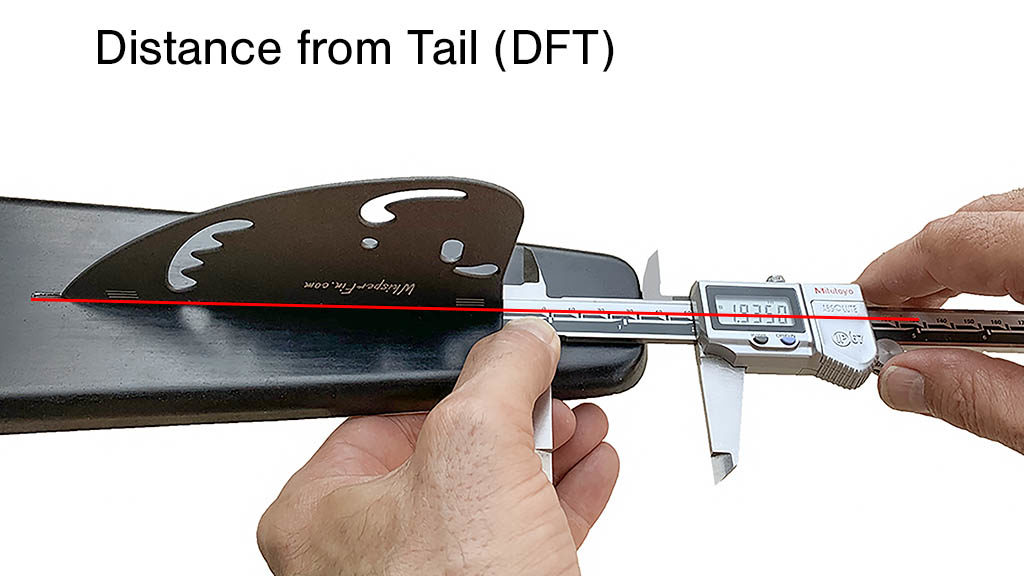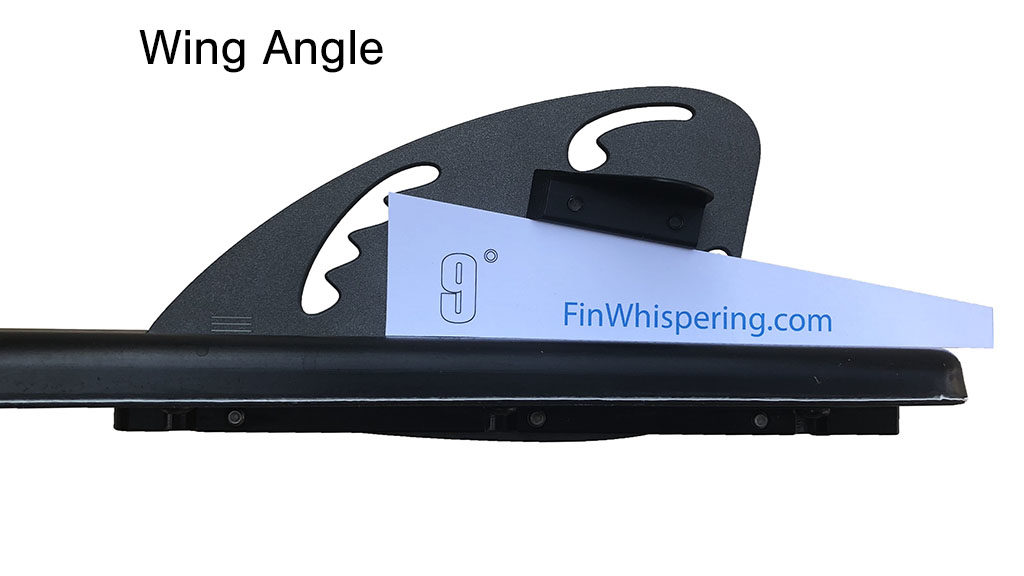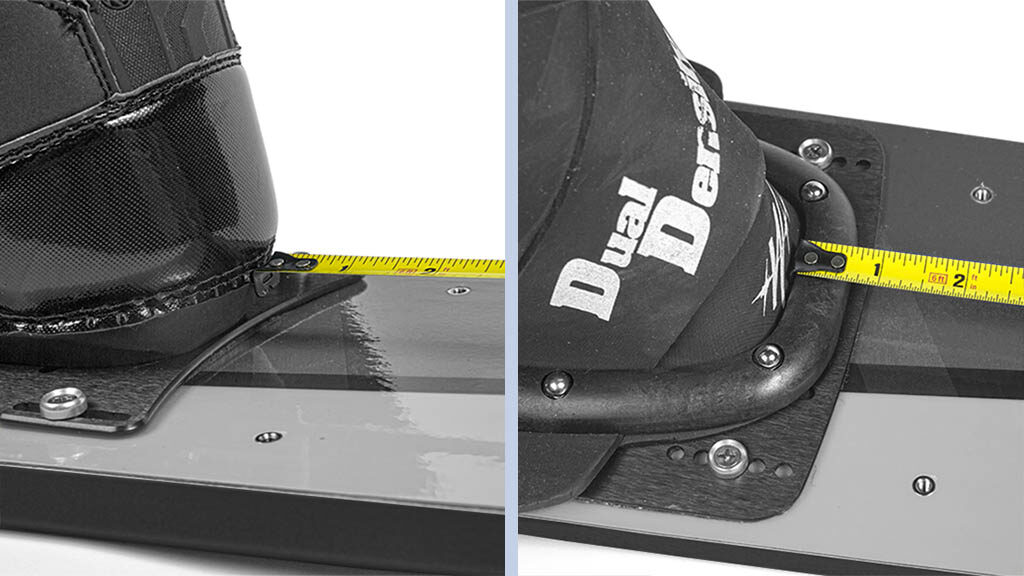Starting Setups
Original WhisperFin
The measurements listed in this database were taken using these industry standard techniques
These setups are called “starting setups” because they are just that—good starting points from which to develop your own personalized setup. Keep in mind that while these setups worked great for someone, that “someone” may have bindings, technique and stature that are completely different than yours. So whether you start with the generic installation setup that came with your fin, or with one of the following model-specific setups, I still recommend you do a little custom tuning for best personal results. And custom tuning is probably easier than you think. Just follow the tuning instructions that came with your fin, or go to: www.finwhispering.com/whisperfin-tuningNot every ski built will be listed in these Starting Setups. If your ski isn’t listed, you can start with the setup for another ski of a similar size and character to yours. And if there is a setup listed for your ski but not in your size, adjust the listed setup as follows:
- Move your bindings ½” for every inch of ski length difference (e.g. If the listed ski 1″ larger than yours, move your bindings forward ½”).
- Change DFT .005″ for every inch of ski length difference (e.g. If the listed ski 1″ larger than yours, increase DFT by .005″).
Original Fin Starting Setups by Ski Brand
Connelly Installation Note:
With Connelly’s unique new fin block, the adjustment set screws contact the top sheet of the ski before you can achieve the desired FD and FL with the WhisperFin. This is not a problem. You can either adjust the fin by hand without the use of the set screws, Dremel out a round hole through the top sheet for the set screws to pass through (do not use a standard drill bit as it may snag and crack the top sheet). Or you can simply force the set screws through the top sheet into the foam core (this works fine and does no structural or cosmetic damage).* Notice the significant difference between the 66″ and 67″ DFT measurements. The 67″ setup was for a 35-off skier who was struggling with too much tip-bite. This short DFT strategy will work to reduce tip-grab for any sized ski. And note that it’s not the short DFT that reduces tip-bite, it’s the short leading edge location (LE).
65″
Nimble
Bf = 28.625
Wing = 8°
FD = 2.540
FL = 5.770
DFT = 1.950
LE = 7.720
66″
Supportive
Bf = 29.125
Wing = 8°
FD = 2.530
FL = 5.760
DFT = 1.905
LE = 7.665
67″
Anti Tip-grab
Bf = 29.625
Wing = 7°
FD = 2.530
FL = 5.760
DFT = 1.805*
LE = 7.565**
*The front (FL) set screw must be removed to achieve this DFT
**This setup can be made nimbler by increasing DFT by up to .080″ or until the tip starts grabbing
68″
65″
66″
67″
Supportive
Bf = 29.375
Wing = 7°
FD = 2.510
FL = 5.750
DFT = 1.880
LE = 7.630
68″
65″
66″
67″
Nimble
Bf = 29.375
Wing = 7°
FD = 2.530
FL = 5.762
DFT = 1.950
LE = 7.712
Supportive
Bf = 29.5
Wing = 7°
FD = 2.540
FL = 5.770
DFT = 1.920
LE = 7.690
68″
64″
Bf = 28.625
Wing = 7°
FD = 2.485
FL = 5.730
DFT = 1.945
LE = 7.675
65″
Bf = 29.25
Wing = 7°
FD = 2.520
FL = 5.755
DFT = 1.920
LE = 7.675
66″
Bf = 29.75
Wing = 7°
FD = 2.530
FL = 5.762
DFT = 1.920
LE = 7.682
67″
Bf = 30.125
Wing = 8°
FD = 2.530
FL = 5.760
DFT = 1.925
LE = 7.685
68″
Bf = 30.625
Wing = 7°
FD = 2.540
FL = 5.770
DFT = 1.920
LE = 7.690
64″
65″
66″
Bf = 29.65
Wing = 7°
FD = 2.525
FL = 5.760
DFT = 1.945
LE = 7.705
67″
Bf = 30.15
Wing = 7°
FD = 2.530
FL = 5.760
DFT = 1.955
LE = 7.715
68″
Bf = 30.65
Wing = 7°
FD = 2.530
FL = 5.760D
FT = 1.950
LE = 7.710
64″
65″
66″
Bf = 29.65
Wing = 7°
FD = 2.500
FL = 5.850
DFT = 1.838
LE = 7.688
67″
Bf = 30.15
Wing = 7°
FD = 2.505
FL = 5.854
DFT = 1.848
LE = 7.702
68″
Bf = 30.65
Wing = 7°
FD = 2.505
FL = 5.854
DFT = 1.850
LE = 7.704
Wing Note: The setups here all assume small wing use. But most, if not all, of the current Goodes work best with the large wing run at 1.5° less angle than your normal small wing setting.Note: These measurements are with the tips (FL) and head (DFT) of a normal caliper, not a slot caliper. FL measurements are very roughly .075″ shorter and DFT measurements about .010″ longer using a slot caliper, but these conversions vary widely depending on ski design.
65.75″
66.5″
Bf = 29.5
Wing = 9°
FD = 2.530
FL = 5.762
DFT = 1.830
LE = 7.592
67.25″
Bf = 29.625
Wing = 9°
FD = 2.530
FL = 5.762
DFT = 1.830
LE = 7.592
68″
Bf = 29.875
Wing = 9.5°
FD = 2.530
FL = 5.758
DFT = 1.840
LE = 7.598
65.5″
Bf = 29.5
Wing = 9° Large
FD = 2.530
FL = 5.762
DFT = 1.810
LE = 7.572
67″
Bf = 29.625
Wing = 9.5° Large
FD = 2.530
FL = 5.762
DFT = 1.840
LE = 7.592
67.75″
Bf = 29.5
Wing = 9.5° Large
FD = 2.525
FL = 5.758
DFT = 1.850
LE = 7.608
68.5″
Bf = 29.875
Wing = 9° Large
FD = 2.525
FL = 5.760
DFT = 1.880
LE = 7.640
*This setup is an estimate
65″
66″
Aggressive
Bf = 28.875
Wing = 9.5°
FD = 2.530
FL = 5.760
DFT = 1.860
LE = 7.620
Less Tip-bite
Bf = 28.875
Wing = 9.5°
FD = 2.530
FL = 5.760
DFT = 1.810
LE = 7.570
67″
Aggressive
Bf = 29.125
Wing = 9°
FD = 2.530
FL = 5.765
DFT = 1.865
LE = 7.630
Less Tip-bite
Bf = 29.125
Wing = 9°
FD = 2.530
FL = 5.765
DFT = 1.820
LE = 7.585
68″
Aggressive
Bf = 29.375
Wing = 9.5°
FD = 2.540
FL = 5.770
DFT = 1.870
LE = 7.640
Less Tip-bite
Bf = 29.375
Wing = 9.5°
FD = 2.540
FL = 5.770
DFT = 1.820
LE = 7.590
65.75″
66.5″
Bf = 29.25
Wing = 9°
FD = 2.530
FL = 5.765
DFT = 1.935
LE = 7.700
Excellent tip hold out of turns, but if you experience tip-grab, shorten LE
67.25″
Bf = 29.375
Wing = 9°
FD = 2.530
FL = 5.765
DFT = 1.840
LE = 7.605
Set up to defend against tip-bite from tip-high approach to turns
68″
Bf = 29.625
Wing = 9°
FD = 2.540
FL = 5.765
DFT = 1.880
LE = 7.645
An accomplished Big Dawg’s setup
64″
65.25″
Aggressive
Bf (N1) = 28.875
Bf (XT) = 28.875
Wing = 9.5°
FD = 2.530
FL = 5.760
DFT = 1.860
LE = 7.620
Less Tip-bite
Bf(N1) = 28.875
Bf(XT) = 28.875
Wing = 9.5°
FD = 2.530
FL = 5.760
DFT = 1.810
LE = 7.570
66″
Aggressive
Bf (N1) = 29
Bf (XT) = 29
Wing = 9°
FD = 2.530
FL = 5.765
DFT = 1.865
LE = 7.630
Less Tip-bite
Bf (N1) = 29
Bf (XT) = 29
Wing = 9°
FD = 2.530
FL = 5.765
DFT = 1.820
LE = 7.585
66.75″
Aggressive
Bf (N1) = 29.375
Bf (XT) = 29.125
Wing = 9°
FD = 2.540
FL = 5.770
DFT = 1.870
LE = 7.640
Less Tip-bite
Bf (N1) = 29.375
Bf (XT) = 29.125
Wing = 9°
FD = 2.540
FL = 5.770
DFT = 1.820
LE = 7.590
64.25″
65.75″
Bf = 28.75
Wing = 9°
FD = 2.535
FL = 5.765
DFT = 1.910
LE = 7.675
66.5″
Bf = 29
Wing = 9°
FD = 2.540
FL = 5.770
DFT = 1.890
LE = 7.660
67.25″
68″
64″
65.5″
66.25″
Bf = 29.625
Wing = 9° Large
FD = 2.540
FL = 5.770
DFT = 1.885
LE = 7.655
67″
65″
66″
Bf = 28 ⅞
Wing = 8°
FD = 2.480
FL = 5.725
DFT = 1.980
LE = 7.705
67″
Bf = 28.75
Wing = 8°
FD = 2.480
FL = 5.725
DFT = 1.985
LE = 7.710
68″
65″
Nimble
Bf = 28.625
Wing = 8°
FD = 2.500
FL = 5.740
DFT = 1.920
LE = 7.660
More Supportive
Bf = 28.625
Wing = 8°
FD = 2.515
FL = 5.750
DFT = 1.915
LE = 7.665
66″
Nimble
Bf = 29.125
Wing = 8°
FD = 2.510
FL = 5.750
DFT = 1.930
LE = 7.680
More Supportive
Bf = 29.25
Wing = 8°
FD = 2.540
FL = 5.770
DFT = 1.900
LE = 7.670
67″
Nimble
Bf = 29.625
Wing = 8°
FD = 2.495
FL = 5.737
DFT = 1.893*
LE = 7.630
* Lengthen DFT until tip grabs
More Supportive
Bf = 29.75
Wing = 8°
FD = 2.530
FL = 5.760
DFT = 1.915
LE = 7.675
For more customized tuning guidance see: WhisperFin Ski-tuning –101 and the Whisperfin Ski-tuning Flowchart
66″
Bf = 29.25
Wing = 7°
FD = 2.535
FL = 5.766
DFT = 1.947
LE = 7.713
67″
Bf = 29.75
Wing = 8°
FD = 2.540
FL = 5.771
DFT = 1.949
LE = 7.720
68″
Bf = 30.25
Wing = 8°
FD = 2.540
FL = 5.771
DFT = 1.959
LE = 7.730
Nimble – Start with these settings if you are light, or consider yourself a finesse skier. The more nimble your setup can be, the better the tip hold will be exiting turns and during the cut. Your setup is too nimble if the tail feels slippery at the end of turns.More Supportive – Start with these settings if you consider yourself a powerful skier who tends to force the ski, if you tend to get tip-grab, or if the nimble settings make the tail feel too slippery.These two setups are NOT at extreme ends of the setup spectrum. If anything, they bracket the middle third. So experimenting with either of these setups is encouraged. If you want more or less tail grip make the fin deeper or shallower. And it’s always a good idea to customize yawing tip-engagement by moving the fin back and forth (forward for more tip engagement and back for less). You want to be as far forward as your technique will allow before the tip starts grabbing occasionally.For more customized tuning guidance see: WhisperFin Ski-tuning –101 and the Whisperfin Ski-tuning Flowchart
65″
Bf = 29.25
Wing = 9°
FD = 2.510
FL = 5.740
DFT = 1.950
LE = 7.690
63.5″
Bf = 28.625
Wing = 8°
FD = 2.440
FL = 5.695
DFT = 1.970
LE = 7.665
66″
Nimble
Bf = 29.625
Wing = 9°
FD = 2.510
FL = 5.745
DFT = 1.950
LE = 7.695
More Supportive
Bf = 29.75
Wing = 9°
FD = 2.540
FL = 5.770
DFT = 1.920
LE = 7.690
67″
Nimble
Bf = 30.125
Wing = 9°
FD = 2.510
FL = 5.740
DFT = 1.940
LE = 7.680
More Supportive
Bf = 30.25
Wing = 9°
FD = 2.530
FL = 5.760
DFT = 1.935
LE = 7.695
68″
Nimble
Bf = 30.75
Wing = 9°
FD = 2.510
FL = 5.750
DFT = 1.960
LE = 7.710
More Supportive
Bf = 30.875
Wing = 9°
FD = 2.530
FL = 5.765
DFT = 1.940
LE = 7.705
69.5″
Bf = 31.125
Wing = 8°
FD = 2.520
FL = 5.755
DFT = 1.950
LE = 7.705
65″
Bf = 29.625
Wing = 8°
FD = 2.510
FL = 5.730
DFT = 1.995
LE = 7.725
67″
Bf = 30.75
Wing = 8°
FD = 2.510
FL = 5.750
DFT = 1.960
LE = 7.710
69″
Bf = 32.0
Wing = 8°
FD = 2.525
FL = 5.760
DFT = 1.945
LE = 7.705
71″
Bf = 32.5
Wing = 8°
FD = 2.520
FL = 5.755
DFT = 1.945
LE = 7.700
Not Finding Your Ski?
Awhile ago, I had a serious snow skiing accident that put an end to both my snow and water skiing. As a result, you’ll notice the starting setups listed above only only cover skis until 2021. But these listings are still helpful.
If you choose a setup for a ski that is similar in nature to your latest ride, it will likely get you surprisingly close to ideal. From there, I encourage you to experiment with changes using the following tools as your guide. Worst case, you can always change back; but if you dare to try, you just might find you can make your ski’s behavior friendlier and friendlier.






